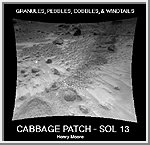|
PHOTO INDEX OF
PRIMARY TARGETS
|
|---|
ASTEROIDS
COMETS
EARTH
JUPITER
KUIPER BELT
MARS
MERCURY
METEORITES
NEPTUNE
OORT CLOUD
PLUTO
SATURN
SOLAR SYSTEM
SPACE
SUN
URANUS
VENUS
ORDER PRINTS
ALL TARGETS
PHOTO CATEGORIES
SCIENCEVIEWS
AMERICAN INDIAN
AMPHIBIANS
BIRDS
BUGS
FINE ART
FOSSILS
THE ISLANDS
HISTORICAL PHOTOS
MAMMALS
OTHER
PARKS
PLANTS
RELIGIOUS
REPTILES
SCIENCEVIEWS PRINTS
|
 |
 |
Cabbage Patch
| Target Name: | Mars |
| Spacecraft: | Mars Pathfinder Rover |
| Produced by: | USGS |
| Copyright: | Copyright Free Policy |
| Date Released: | 14 October 1997 |
|
Related Document
Download Options
This Sojourner rover image of the Cabbage Patch shows small rounded
objects on the surface that are about 3-4 cm across. Some of these
are within excavations, which are about 0.5 cm wide. Several
questions arise about the pebbles: Why are they rounded? Where did
they come from? What do they mean?
Geologists use MULTIPLE WORKING HYPOTHESES when attempting to explain
observations. Some hypotheses that could account for the pebbles are:
- They were rounded during transport by waters of catastrophic
floods and deposited on the Ares Vallis flood plain.
- They were rounded by wave action on an ancient Martian beach.
- They were rounded during glacial transport.
- They are glasses that were produced by melting during impact
cratering. The glass was first ejected from the crater, then molded
into spherical shapes or drops as it traveled through the atmosphere,
and finally was deposited at the sites.
- They are spatter from lava flows.
- They are nodules brought up from the deep Martian interior by lava
flows or pyroclastic eruptions.
- They are concretions formed in sedimentary rocks.
- They came from ancient conglomerate rocks. The pebbles were
rounded by water action and subsequently lithified into conglomerate
rocks. Later, the waters of catastrophic floods transported the
conglomerates and deposited them on the Ares flood plain. The pebbles
were then freed from the rocks by weathering.
- A combination of the above.
Mars Pathfinder is the second in NASA's Discovery program of low-cost
spacecraft with highly focused science goals.
|
|
